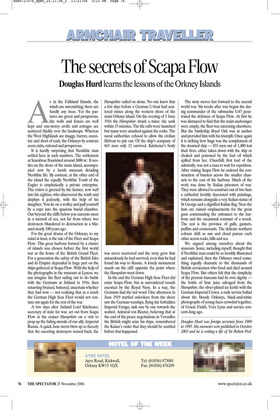The secrets of Scapa Flow
Douglas Hurd learns the lessons of the Orkney Islands As in the Falkland Islands, the winds are unremitting; there are hardly any trees. Yet the pastures are green and prosperous, the walls and fences are well kept and one-storey crofts and cottages are scattered thickly over the landscape. Whereas the West Highlands are shaggy, barren, eccentric and short of cash, the Orkneys by contrast seem calm, rational and prosperous.
It is hardly surprising that Neolithic man settled here in such numbers. The settlement at Scarabrae flourished around 3000 BC. It nestles on the shore of the main island, accompanied now by a lavish museum detailing Neolithic life. By contrast, at the other end of the island the equally Neolithic Tomb of the Eagles is emphatically a private enterprise. The visitor is greeted by the farmer, now well into his eighties, who discovered the tomb and displays it jealously, with the help of his daughter. You lie on a trolley and pull yourself by a rope into the spacious burial chamber. Out beyond the cliffs below you currents meet in a turmoil of sea, not far from where two destroyers blundered to destruction in a blizzard nearly 100 years ago.
For the great drama of the Orkneys, to my mind at least, is the tale of the Fleet and Scapa Flow. This great harbour formed by a cluster of islands was chosen before the first world war as the home of the British Grand Fleet. For a generation the safety of the British Isles and its Empire depended in large part on the ships gathered at Scapa Flow. With the help of the photographs in the museum at Lyness, we can imagine the fleet sailing out to do battle with the Germans at Jutland in 1916, then returning bruised, battered, uncertain whether they had won — not realising that as a result the German High Seas Fleet would not venture out again for the rest of the war.
A few days after Jutland Lord Kitchener, secretary of state for war, set out from Scapa Flow in the cruiser Hampshire on a visit to prop up the failing morale of our ally, Imperial Russia. A quick June storm blew up so fiercely that the escorting destroyers turned back; the Hampshire sailed on alone. No one knew that a few days before a German U-boat had scattered mines along the western shore of the main Orkney island. On the evening of 5 June 1916 the Hampshire struck a mine; she sank within 15 minutes. The life rafts were launched but many were smashed against the rocks. The naval authorities refused to allow the civilian lifeboat to put out. Of the ship’s company of 665 men only 12 survived. Kitchener’s body was never recovered and the story grew that miraculously he had survived, even that he had found his way to Russia. A lonely monument stands on the cliff opposite the point where the Hampshire went down.
In the end the German High Seas Fleet did enter Scapa Flow, but as surrendered vessels escorted by the Royal Navy. In a way, the Germans had the last word. One afternoon in June 1919 startled onlookers from the shore saw the German warships, flying the forbidden Imperial Ensign, sink one by one towards the seabed. Admiral von Reuter, believing that at the end of the peace negotiations in Versailles the British might seize his ships, remembered the Kaiser’s order that they should be scuttled before that happened. The story moves fast forward to the second world war. Six weeks after war began the daring commander of the submarine U47 penetrated the defences of Scapa Flow. At first he was dismayed to find that the main anchorages were empty; the fleet was exercising elsewhere. But the battleship Royal Oak was at anchor and provided him with his triumph. Once again it is striking how huge was the complement of the doomed ship — 833 men out of 1,400 lost their lives, either taken down with the ship or choked and poisoned by the fuel oil which spilled from her. Churchill, first lord of the admiralty, was not a man to wait for repetition. After visiting Scapa Flow he ordered the construction of barriers across the smaller channels to the east of the harbour. Much of the work was done by Italian prisoners of war. They were allowed to construct out of two huts a cathedral lavishly decorated with paintings, which remains alongside a very Italian statue of St George and a dignified Italian flag. Near the huts are ruined emplacements for the great guns commanding the entrances to the harbour and the occasional remnant of a wreck. The rest is the province of gulls, gannets, puffins and cormorants. The delicate northern colours shift as sun and cloud pursue each other across rocks, hills and sea.
We argued among ourselves about the museum. Some, including myself, thought that if Neolithic man could be so lavishly illustrated and explained, then the Orkneys owed something equally dramatic to the thousands of British servicemen who lived and died around Scapa Flow. But others felt that the simplicity of the present museum had its own dignity the bottle of lime juice salvaged from the Hampshire, the silver-plated ice kettle with the German Imperial Crown, a rude service ballad about the bloody Orkneys, black-and-white photographs of young faces crowded together, of Gracie Fields, Vera Lynn and service concerts long ago.
Douglas Hurd was foreign secretary from 1989 to 1995. His memoirs were published in October 2003 and he is writing a life of Sir Robert Peel.


























































































 Previous page
Previous page